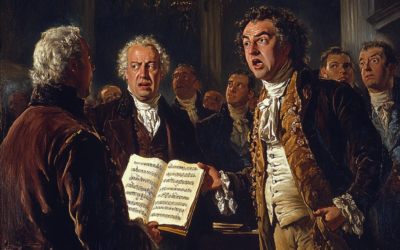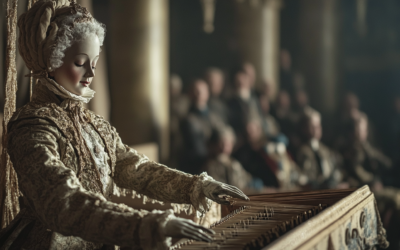Unpacking Mozart's K.89
Unpacking Mozart's K.89
This post explores the simplistic nature of Mozart’s Kyrie K.89, revealing the truth behind his early canonic compositions and their implications on his perceived genius.
Mozart: The Fall of the Gods
This book offers a fresh and critical look at the life of Wolfgang Amadeus Mozart, challenging the myths that have surrounded him for centuries. We strip away the romanticised image of the “natural genius” and delve into the contradictions within Mozart’s extensive biographies. Backed by nearly 2,000 meticulously sourced citations, this work invites readers to explore a deeper, more complex understanding of Mozart. Perfect for those who wish to question the traditional narrative, this biography is a must-read for serious music lovers and historians.
"The incapacity to adhere to compositional rules illustrates the absence of a school and a teacher; mere imitation does not equate to mastery."
Mozart: The Fall of the Gods
When we think of Wolfgang Amadeus Mozart, the image of a prodigious genius often overshadows the reality of his musical development. One area of his work that deserves scrutiny is his treatment of canons, particularly in his Kyrie K.89. While canons are frequently seen as an entry point into the world of polyphony, Mozart’s versions reveal a stark simplicity that belies the complexities often associated with great composers.
The canon, a straightforward and rigorous compositional technique, is typically the first form grasped by children learning music. Yet, Mozart’s attempts at this form in his K.89 are fundamentally elementary, mainly employing unison voices and imitating the style of his supposed mentor, the Marchese de Ligniville. The notion that these canons serve as evidence of Mozart’s mastery of counterpoint is questionable, as his works primarily reflect a lack of deeper understanding rather than a profound artistry.
Many scholars, including Hermann Abert and Neal Zaslaw, have suggested that Mozart may have benefitted from Ligniville’s teachings during a brief stay in Florence. However, the reality of this mentorship remains vague, with only a few days available for instruction. The assertion that K.89 demonstrates Mozart’s familiarity with counterpoint is undermined by its reliance on copying rather than original composition. The piece consists of merely repeating simple motifs, leading to a product that lacks musical depth and sophistication.
The K.89 is essentially a pastiche, with Mozart replicating two-bar and three-bar phrases rather than crafting a genuinely innovative work. This method of composition results in a repetitive structure that fails to engage the listener on any meaningful level. Critics have noted that the final cadenza is riddled with compositional errors, indicating a lack of guidance and proper schooling in counterpoint.
Furthermore, the idea that K.89 should be held up as a testament to Mozart’s genius is misguided. The work serves as a reminder of the danger in romanticising his early output. While Mozart may have been adept at imitating others, true innovation and mastery require more than mere replication; they necessitate a comprehensive understanding of musical language and form.
In essence, K.89 stands as a historical curiosity rather than a hallmark of genius. It exemplifies the early stages of a composer still grappling with the fundamental principles of music rather than demonstrating an accomplished mastery of the craft.
You May Also Like
When the Myth Collapsed
Vienna exposed the myth: La Finta semplice was riddled with errors, and Wolfgang’s supposed opera genius was nothing more than Leopold’s fabrication. With their reputation in ruins, father and son turned to Italy, hoping to rewrite history.
The London Notebook and the Vienna Disaster
Far from the myth of a flawless young genius, Mozart’s London Notebook reveals musical struggles and guided exercises, while the Vienna opera disaster proved that his father played a far greater role in his compositions than legend would have us believe.
Versailles, Vanity, and the Pursuit of Prestige
Leopold Mozart’s letters transformed his son’s European tour into a carefully staged fantasy—filled with exaggerated encounters, fabricated royal admiration, and a relentless pursuit of social prestige. But how much of it was real?
The Fabricated Childhood of Mozart
The legend of young Mozart’s divine genius crumbles under scrutiny, revealing a childhood dictated by Leopold’s ambition, carefully constructed myths, and a relentless pursuit of fame at the expense of genuine artistic education.
The Man Behind the Myth
Leopold Mozart’s legacy has been shaped by myths and hagiographies, but his letters reveal a man more concerned with financial gain and self-promotion than artistic integrity. Was he truly a devoted father, or simply an opportunist?
Constanze vs. The Catholic Church
For over two centuries, scholars have debated the circumstances surrounding Mozart’s burial. Constanze Mozart’s supposed inability to mark his grave, the confrontation with the Catholic Church over funeral masses, and the baffling disappearance of Mozart’s body all contribute to a mystery stranger than fiction. Did a powerful group keep her silent? And what really happened to Mozart’s remains?







